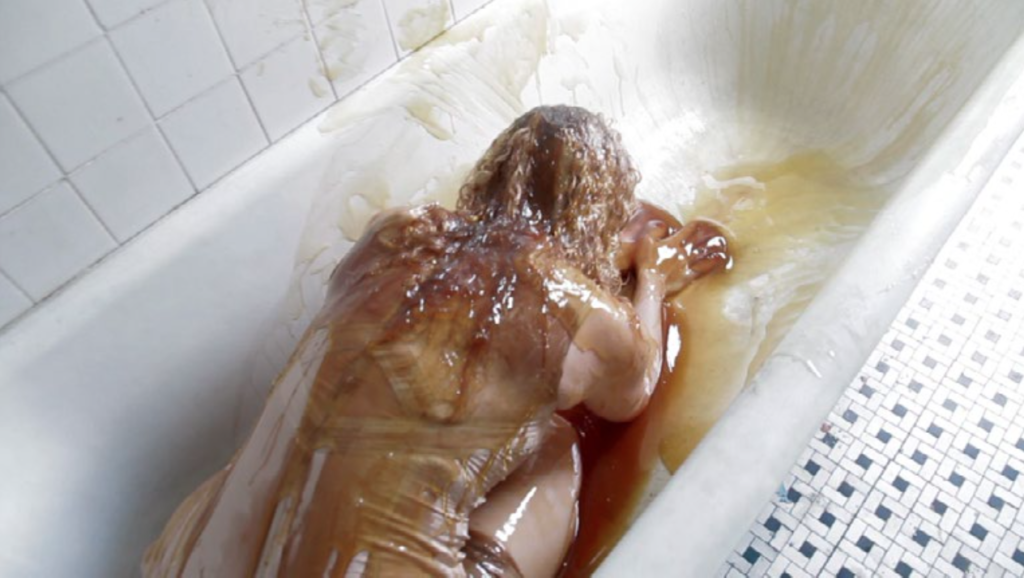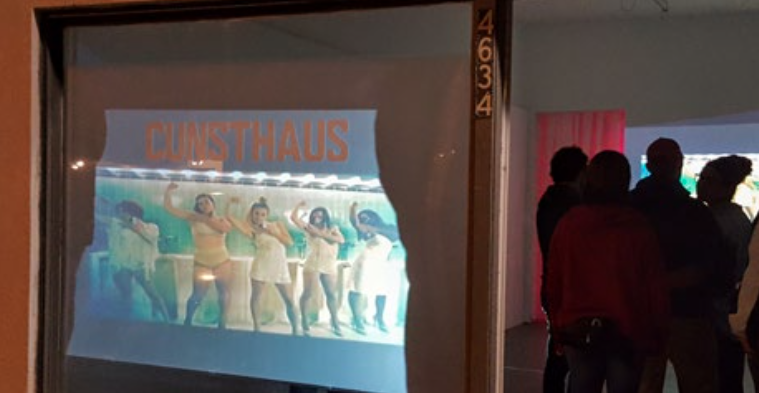On a spring evening in Tampa, Florida, a warm breeze carried Sarah Howard, Curator of Public Art and Social Practice at USF’s Institute for Research, onto a patio of one of the city’s many foodie spots. Wearing rose-tinted glasses and a generous smile, Howard met with Micheal Hooker, an arts-based psychology writer and performance artist. The following is an excerpt of their conversation about the importance of space, social justice, and why participatory art is so relevant today.
Micheal Hooker: Wow, those glasses are spectacular!
Sarah Howard: Well, they are rose-tinted, an appropriate filter for all the traumatic events happening in the world.
Way to use your curatorial lens for self-care. Seriously, it takes stamina to maintain a level head these days. There is so much momentum (in public art and social justice) right now that must be sustained.
With the collective trauma being experienced presently, our society has become more publicly activated, both online and in reality, about marginalization and social justice issues.
And all the issues being addressed are intrinsically linked. Meanwhile, to reach a wider audience, the spaces activists use have to be accessible. You deal with this at USFCAM; what are you seeing?
A lot of the messaging from activism in the art world and beyond finds power in the spaces where the messages are portrayed. Is it an institutional voice—is that voice free from the sponsorship of the institution? How does that voice compare with those found in civic spaces? Is it a protest/intervention into private/public space? I’m seeing a lot of transitions, exchange and overflow between these spaces, amplifying the voices.

Pour Blue, inkjet photographic print on silk
Right, because art and propaganda have a sordid love affair, especially when it comes to conventional platforms and curation. That’s why performance art, within a public sphere, lends itself so easily to social justice issues. Artists and activists are wise to this, which is exciting.
And we have a new generation that is more predicated on experiencing art in these ways, an integrated approach to incorporating art into their lives. Art is not separate, but it’s so much more about how our lives are designed and performed. Perhaps there’s this divide now between your digital life and your…
“Real Life?”
Yes, it feels like it’s become a duality. We are able to experience and live in two worlds or more. I think the digitally native generation is able to synthesize the digital realm as integral to their personal experience, and they are performative in that medium, and the real life performance provides them with a unique way into experiencing the arts.
If I’m understanding you right, as a curator you see the digital world as creating new spaces to navigate and occupy through the imagination. It offers new facilities for participating with art.
Yes, precisely. Plus the digital world has expanded engagement with physical spaces, extending our notion of bearing witness. Through virtual or augmented technologies, our understanding of physical spaces we haven’t visited can be informed. So, there’s a potential for expectation about a space that other people who haven’t accessed this info might not have.
And online reviews offer an ekphrastic version of a space. I agree that technology offers another creative outlet, but interacting with it can seem like giving away something precious, a piece of one’s soul, when work suddenly becomes disposable. Painters and photographers lament the pressures of posting on Instagram for this reason. Participatory art is immune to this problem. By nature it is temporal, pedestrian, more accessible.
True, how does our online world align with the public/performative space? The lack of expectation is what interests me about working in the public realm. The unexpected encounter. People often happen upon public art, outside the institutional space, going about their daily lives, without preconceived notions about specific behavior or response. Art in the public sphere provides accessibility to the viewer both physically and spiritually and I think there can be something magical discovered in those encounters and interventions.
Right, participatory art disrupts expectation and promotes spontaneity—something our overly designed world suppresses.
And perhaps experiencing works through spontaneous action appeals to a person’s own sense of discovery in ways that experiencing artwork through the established modes of observing and seeing often don’t. Exposure to art, even if it’s not recognized as art, provides the ability to see, hear, and sense creative expressions, and creates an opportunity to interpret and be transformed by art, which is integral to nurturing healthy human conditions. That experience can transcend space, whether its institutional, civic, or even digital space, which is why public art—and in general, access to the arts—is so vital to the fabric of our lives and our landscape, whether it’s urban, suburban, or rural.

Of Covenant oan Oath, inkjet photographic print film still
Indeed, and modern neuroscience is consistently proving your points about these benefits. Returning to trauma, innovative scientists recognize what indigenous peoples and artists already know: art is therapeutic. Art therapy interventions encourage abstract thinking, which develops new experiences of safety. The research in these fields is reassuring us that awakening our primal knowledge can affect greater change, rather than…
Rather than just creating awareness, it’s actually having a visceral effect on the being.
Totally! Embodiment is a condition for bringing awareness into consciousness. Incidentally, RoseLee Goldberg says artists return to performance art when they become frustrated with other mediums. When painting or photography doesn’t work, they use their bodies to answer internal questions. The same principle goes with activism. It’s shamanic.
It’s going back to that idea of informing or knowing the body and its function through doing. Through activating our primal nature, performance is a primal activity.
Yeah! The primal worldview participates with everything. Public art and activism illustrate this perspective; their rituals permeate barriers.
The level of participation, activism, and social justice movements occurring now is critically important to the art that being produced today. I’m thinking about the essay where you referenced Marshall McLuhan’s point about marching back into the future—just that idea that we have our whole future ahead of us and generations behind us are looking to the future generations to find solutions to so many vital issues, and art is one vehicle in this shamanistic ritual.

When streams of past/future meet in the present, the collective mind shifts. You mentioned dual realities; art integrates them. To quote McLuhan again, “the medium is the message,” so this resurgence in active participation is significant. You provide a platform for these messages at USFCAM, thereby making fissures in the boundaries between oppressive spaces and liberated ones. As does the collective you participate in, Cunsthaus.
I like to think I am exploring ways to work transcend boundaries. We just celebrated our first year at Cunsthaus, a space adjacent to Tempus Projects in Tampa. Modeled after the German Kunsthaus, the members are artists, art historians, curators, and cultural producers who are united through the mission of offering a diverse range of cultural programs through a collaborative and feminist curatorial perspective.
You’re navigating liminal spaces, like bees! Curation functions like ether wherein all natural elements exist.
It’s almost like the amalgamation of the senses.
Yeah, cooking in an alchemical vessel.
So, thinking about cooking things up, I’m excited you will be presenting a participatory-based performance at Cunsthaus this summer. Can you talk about the project and what issues you are addressing through the work?
Thanks, I’m grateful for Cunsthaus. The performance, 100 pitchers (ofHoney), is inspired by a poem, deals with a fatal epidemic experienced through bee populations, and provides a communal initiation through remembering their importance to the ecosystem.
So the performance encourages audience participation in the ritual itself? Informing knowledge through the act of experience?
Absolutely, it’s a modern cult ritual in becoming bee-conscious. Honey is the lens we’ll use, not unlike your glasses!
Micheal Hooker’s show will be at Cunsthaus from July 22 – Aug 19. 4636 N. Florida Ave, Tampa, Fl.
You can see more at: Tempus-Projects.com/Cunsthaus
